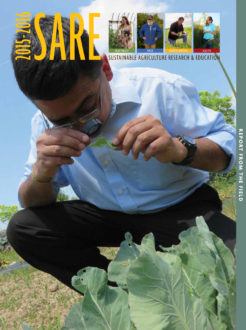Urban agriculture is not a new concept, but it is getting more attention these days. The social component to urban farming has a lot of value, even if the volumes of food involved may not be large. These include increased access to healthy, affordable food, expanding green spaces and community participation that builds social capital. Further, urban agriculture raises awareness about the larger food system, which spans cities and countrysides.
In recent years Northeast SARE has funded some very successful urban ag projects. For example, The Farm Alliance of Baltimore City, which in its first two years harvested 38,902 pounds of products, coordinated 10,983 volunteer hours, generated $165,756 in sales and hosted 5,334 students and youth on member farms.
In New York City, The Brooklyn Grange used 2.5 acres of rooftops to grow market vegetables that were sold fresh to the community. The project also composted over 150,000 pounds of organic waste on a nearby lot in a navy yard.
Sustainable Urban Development in West Philadelphia created a guide to help residents increase their access to fresh, healthy and affordable food by reclaiming vacant lots in the city and building for-profit urban farms.
As part of their state plan of work, SARE coordinators in Rhode Island and Connecticut are engaged in a project that provides training to 25 urban farmers on crop production techniques, soil health, nutrient management, crop rotation, cover crops and pest control.
Grants Awarded in the Northeast
The following is a summary of SARE funding in the Northeast. State-by-state grant data is also available. To learn about SARE-funded activities and opportunities in Northeastern states, visit our state program pages. Visit the projects database to search individual projects by type, topic, state and other criteria.
Grant Proposals and Awards, 2014-2015
| Grant Type |
Preproposals
Received1 |
Full Proposals
Invited |
Full Proposals
Received |
Proposals
Funded |
Funding
Total |
| Research and Education | 153 | 53 | 45 | 19 | $2.6 million |
| Professional Development | 32 | 21 | 20 | 12 | $1.2 million |
| Farmer/Rancher | N/A | N/A | 109 | 44 | $532,410 |
| On-Farm Partnership | N/A | N/A | 119 | 56 | $782,633 |
| Graduate Student | N/A | N/A | 106 | 43 | $612,477 |
| 1 The use of a preproposal process varies by region. It serves to screen project ideas for the larger and more complex grant programs, to reduce applicants’ proposal preparation burden and the proposal review burden for SARE’s volunteer reviewers. | |||||
Total Grants Awarded in the Northeast, 1988-2015
| Grant Type | Grants Awarded | Total Dollar Amount |
| Research and Education | 347 | $39.9 million |
| Professional Development | 137 | $10.7 million |
| Farmer/Rancher | 732 | $4.4 million |
| On-Farm Partnership | 250 | $2.9 million |
| Graduate Student | 111 | $1.6 million |
| Community Innovation | 108 | $1.4 million |
| Regional Total | 1,685 | $60.9 million |
Finding Answers for an Emergent Oyster Farming Industry
As more oyster fishermen turn from catching wild oysters to farming them, basic information is needed to improve the efficiency and productivity of the industry. Some of those research needs are being met by SARE-funded projects bringing together farmers and Extension specialists.
Sustainable Cropping Systems for Northeastern Dairies
SARE: Advancing Diverse Cropping Systems Penn State researchers have found that dairy farmers can save up to 70 pounds of nitrogen per acre by injecting manure instead of broadcasting it. Photo by Robert Meinen When Heather Karsten, a new PhD student, stepped off the plane in New Zealand with a Fulbright Award to study grazing systems, she […]
To Improve the Soil, First Know the Soil
SARE: ADVANCING SOIL HEALTH The importance of soil health cannot be overstated. It supports vigorous plant growth by promoting the efficient use of nutrients and water, protecting against erosion and compaction, and aiding in disease and pest management. Soil health drives farm productivity and resilience against weather extremes. But the soil is an incredibly complex environment, and for farmers […]

